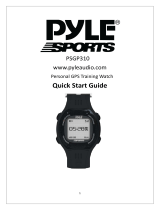
Table of Contents
Introduction.....................................................................1
Keys............................................................................................ 1
Locking the Keys....................................................................1
Charging the Device................................................................... 1
Pairing Your Smartphone with Your Device............................... 1
Support and Updates.................................................................. 1
Setting Up Garmin Express................................................... 1
Activities......................................................................... 1
Starting an Activity...................................................................... 2
Stopping an Activity.................................................................... 2
Sailing......................................................................................... 2
Tack Assist.............................................................................2
Calibrating the Tack Assist................................................2
Sail Racing............................................................................. 2
Setting the Race Timer..................................................... 2
Setting the Starting Line.................................................... 2
Setting the Sailing Units.................................................... 2
Fishing........................................................................................ 2
Going Fishing......................................................................... 2
Tides........................................................................................... 3
Viewing the Tide Data............................................................ 3
Anchor........................................................................................ 3
Marking Your Location as a Waypoint................................... 3
Anchor Settings......................................................................3
Boat Data.................................................................................... 3
Streaming Boat Data..............................................................3
Skiing.......................................................................................... 3
Going Cross-Country Skiing.................................................. 3
Going Downhill Skiing or Snowboarding................................ 3
Viewing Your Ski Runs......................................................3
Hiking.......................................................................................... 3
Going for a Hike..................................................................... 3
Running...................................................................................... 4
Going for a Run......................................................................4
Using the Metronome.............................................................4
Biking.......................................................................................... 4
Going for a Ride..................................................................... 4
Swimming................................................................................... 4
Going for a Pool Swim........................................................... 4
Swim Terminology.............................................................4
Stroke Types..................................................................... 4
Resting During Pool Swimming.........................................4
Training with the Drill Log..................................................5
Going for an Open Water Swim............................................. 5
Water Sports............................................................................... 5
Starting a Stand Up Paddle Boarding Activity....................... 5
Starting a Rowing Activity...................................................... 5
Multisport.................................................................................... 5
Starting a Triathlon or Multisport Activity............................... 5
Creating a Custom Activity.....................................................5
Indoor Activities.......................................................................... 6
Locating a Lost Mobile Device.................................................... 6
Golfing........................................................................................ 6
Playing Golf............................................................................6
Hole Information.....................................................................6
Viewing Layup and Dogleg Distances................................... 6
Using the Golf Odometer....................................................... 6
Keeping Score....................................................................... 6
Reviewing Scores.................................................................. 6
Measuring a Shot................................................................... 6
Training........................................................................... 6
Setting Up Your User Profile.......................................................6
Fitness Goals......................................................................... 6
About Heart Rate Zones
........................................................ 7
Setting Your Heart Rate Zones......................................... 7
Letting the Device Set Your Heart Rate Zones................. 7
Heart Rate Zone Calculations........................................... 7
About Lifetime Athletes.......................................................... 7
Setting Your Power Zones..................................................... 7
Activity Tracking..........................................................................7
Turning On Activity Tracking.................................................. 7
Using the Move Alert..............................................................8
Auto Goal............................................................................... 8
Sleep Tracking....................................................................... 8
Using Automated Sleep Tracking......................................8
Using Do Not Disturb Mode.............................................. 8
Intensity Minutes.................................................................... 8
Workouts.....................................................................................8
Following a Workout From the Web.......................................8
Starting a Workout................................................................. 8
About the Training Calendar.................................................. 8
Using Garmin Connect Training Plans.............................. 8
Interval Workouts........................................................................ 8
Creating an Interval Workout................................................. 8
Starting an Interval Workout.................................................. 9
Stopping an Interval Workout.................................................9
Using Virtual Partner®................................................................ 9
Setting a Training Target............................................................ 9
Cancelling a Training Target.................................................. 9
Racing a Previous Activity.......................................................... 9
Personal Records....................................................................... 9
Viewing Your Personal Records............................................ 9
Restoring a Personal Record................................................. 9
Clearing a Personal Record................................................... 9
Clearing All Personal Records............................................. 10
About Training Effect................................................................ 10
Clock.............................................................................. 10
Setting an Alarm....................................................................... 10
Starting the Countdown Timer.................................................. 10
Using the Stopwatch................................................................. 10
Setting Sunrise and Sunset Alerts............................................ 10
Navigation..................................................................... 10
Projecting a Waypoint............................................................... 10
Saving Your Location............................................................... 10
Editing Your Saved Locations.................................................. 10
Deleting All Saved Locations.................................................... 10
Navigating to a Destination....................................................... 10
Navigating with Sight 'N Go...................................................... 11
Compass...................................................................................11
Map........................................................................................... 11
Panning and Zooming the Map............................................ 11
Navigating To Your Starting Point............................................ 11
Altimeter and Barometer........................................................... 11
History........................................................................... 11
Using History............................................................................ 11
Multisport History................................................................. 11
Viewing Your Time in Each Heart Rate Zone...................... 11
Viewing Step Totals.................................................................. 11
Viewing Data Totals.................................................................. 12
Deleting History........................................................................ 12
Using the Odometer..................................................................12
Connected Features..................................................... 12
Enabling Bluetooth Notifications............................................... 12
Viewing Notifications............................................................ 12
Managing Notifications.........................................................12
Turning Off Bluetooth Technology....................................... 12
Turning On and Off Bluetooth Connection Alerts................ 12
Locating a Lost Mobile Device.................................................. 12
Table of Contents i




















